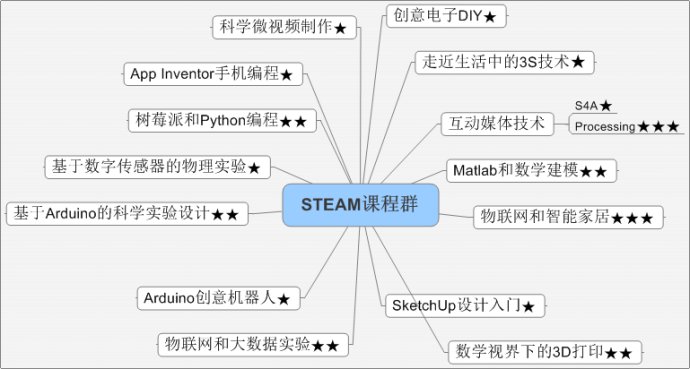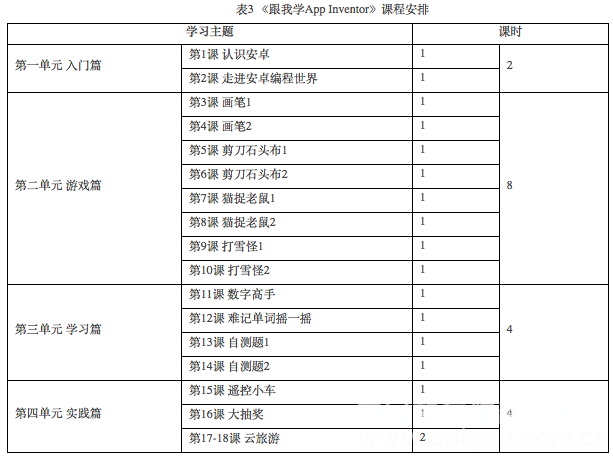(1) Flat curriculum structure
The courses included in the STEAM course group supported by Maker Space are independent in content and different in the course objectives, but they are closely connected and dependent on each other. As shown in Figure 1, the various STEAM courses form the STEAM course group and are a flat curriculum system design. Considering STEAM as an elective course on campus, it is difficult to establish a rigorous curriculum knowledge system on its own. Flattening seems to be simple, but it is actually a wise choice. Although the learning of each STEAM course does not stipulate its context, its difficulty is distinguished by different star ratings. One of the stars is the easiest and the most difficult is Samsung. In the first semester of the first year of high school, the STEAM course is mainly based on the difficulty of opening a star.

Figure 1 Schematic diagram of the construction of the STEAM course group supported by the maker space
Some of the STEAM courses are as follows:
"Arduino Creative Robot" course selects Arduino, the most famous open source robot platform in the world. It follows STEAM's teaching philosophy and combines tools such as puncher, 3D printer and laser cutting machine to DIY personalized robot to cultivate students' design ability and practical ability. , logical thinking ability and practical innovation ability.
The "App Inventor" course is combined with the MIT Lab's App Inventor software. Students use the App Inventor platform to develop mobile application ideas and make full use of various sensors on the mobile phone to model and apply the actual data obtained.
The Interactive Media Technology course is a course that covers teaching content related to computers, smartphones, sensor technology, and artificial intelligence technologies. By studying the "fun" human-computer interaction technology in interactive media works, students can design, produce interactive media works, experience the application of technology in life, and improve STEAM literacy.
The IoT and Big Data course focuses on IoT technology. Students build hardware and write programs based on actual needs, simulating the connection of objects. This course enhances students' ability to read Arduino programs, learn basic program modifications, and use the Internet of Things to solve real-world problems.
The 3D Printing under the Vision of Mathematics has designed topics such as “First Knowing 3D Printingâ€, “3D Mathematical Museumâ€, “SCAD Basic Operationâ€, “SCAD Basic Stereo Modelâ€, “SCAD Basic Language†and “SCAD Integrated Applicationâ€. The process of 3D modeling focuses on cultivating students' modeling awareness and improving students' basic abilities such as theoretical proof, computational solution, data processing, language organization and language expression.
From the above training objectives, it can be seen that the STEAM course group is rich in content and focused, and can well cultivate students' ability to comprehensively apply subject knowledge (biological, chemical, geography, physics, etc.) to understand and transform nature, and correctly understand and use them. The ability to manage and evaluate technology, the ability to discover and solve mathematical problems in real situations, and the ability to understand the engineering design and development process of technology.
(2) Teaching practice of interlocking
The STEAM class emphasizes students' design ability and problem solving in the “disordered†learning situation, and requires students to transform the knowledge and processes of each subject into different aspects of exploring the world's interconnections. In the teaching process, most of the STEAM courses adopt the project learning method, which decomposes the course content into specific projects for teaching and learning, organically integrates knowledge explanation and practical practice, and gives students sufficient time to solve practical problems in practice. For example, "Arduino Creative Robot" divides the course into three units, which are clustered from three aspects: LED, fan, and car (see Table 2). "App Learning from Inventor" divides the course into an introductory chapter and a game. , study articles, practical articles (see Table 3), through the shallow and deep, step-by-step curriculum content, students are finally required to complete a relatively complete functional APP.


In addition, the following points should be noted in the opening of this STEAM course group. The first is the opening time of the course. In order to ensure the student's practice time, the STEAM course is basically carried out in two sessions; the second is the student selection rules. Several courses in this STEAM course group are offered as electives for students to choose freely. Students can only choose one course at a time, and can not repeat the selection; the third is the course software and hardware platform. In this STEAM course group, open source software and hardware are basically used as the course platform, such as Arduino, Raspberry Pi, etc. in hardware, ArduBlock, Mixly, App Inventor, Scratch, S4A and Processing in programming, in 3D modeling. Aspects use SketchUp and OpenScad, respectively.
Get excited about using your bathroom; find inspiration for the perfect bathroom. Our bathroom furniture and décor not only give you the perfect look, but gives you the opportunity to declutter with our space-saving cabinets and bathroom furniture.
See our sleek and modern looks, rustic vibes, or go for a timeless look in your new bathroom.
Not only will your products last, you'll find innovative technology in every part of the bathroom.
Bathroom Furniture,Bathroom Wall Cabinets,Bathroom Mirror Cabinets,Bathroom Tall Cabinets
HOPE IKEA , https://www.skywardrobes.com